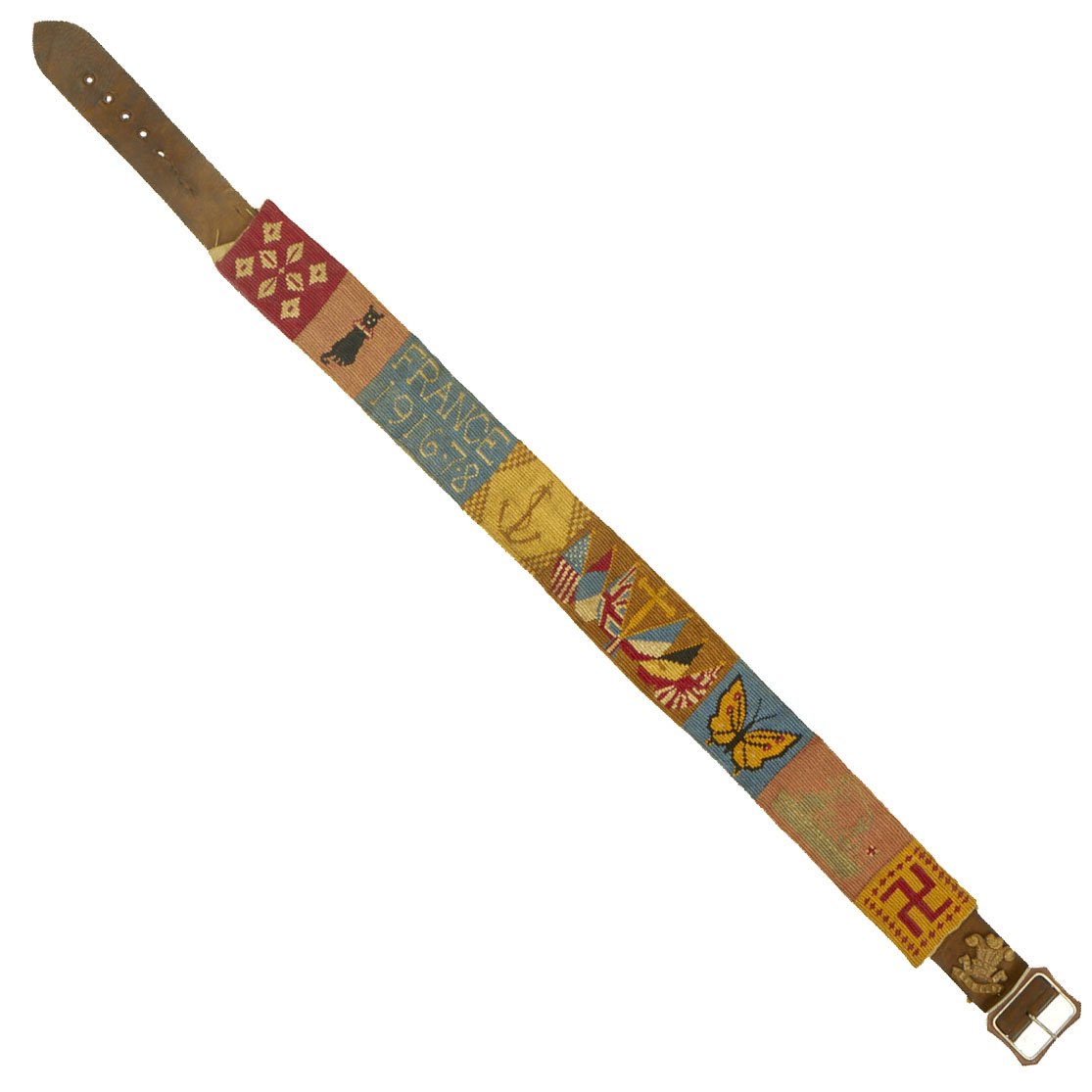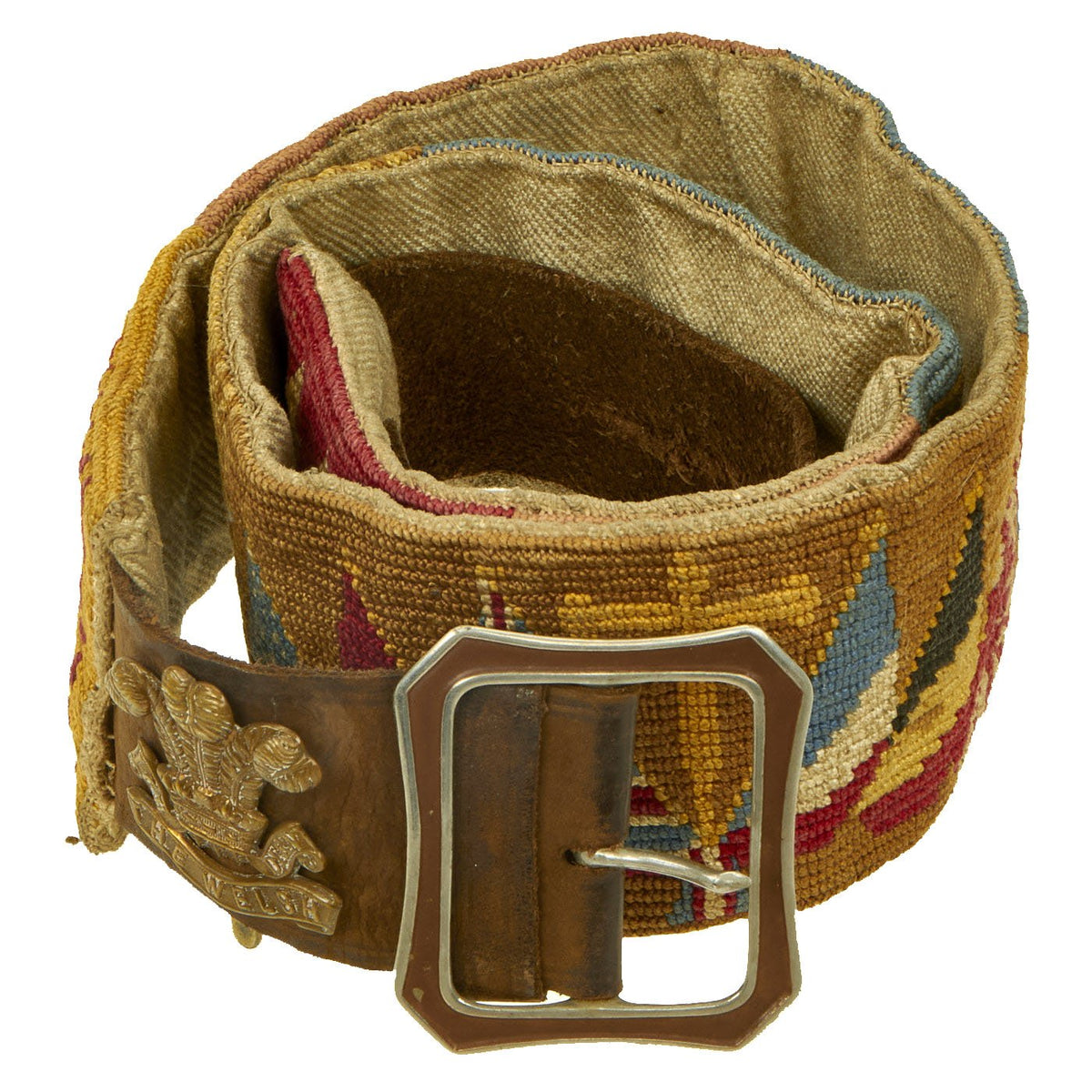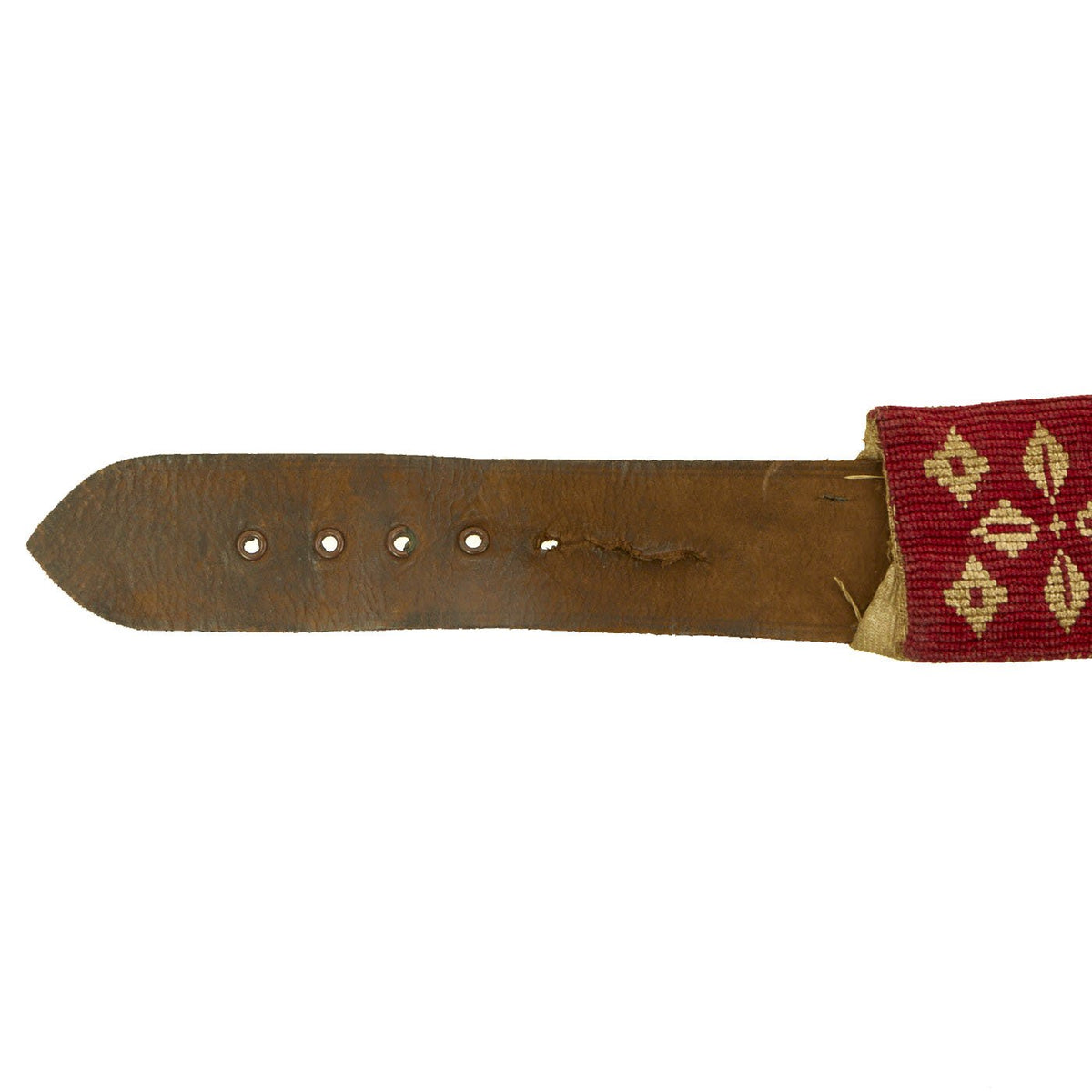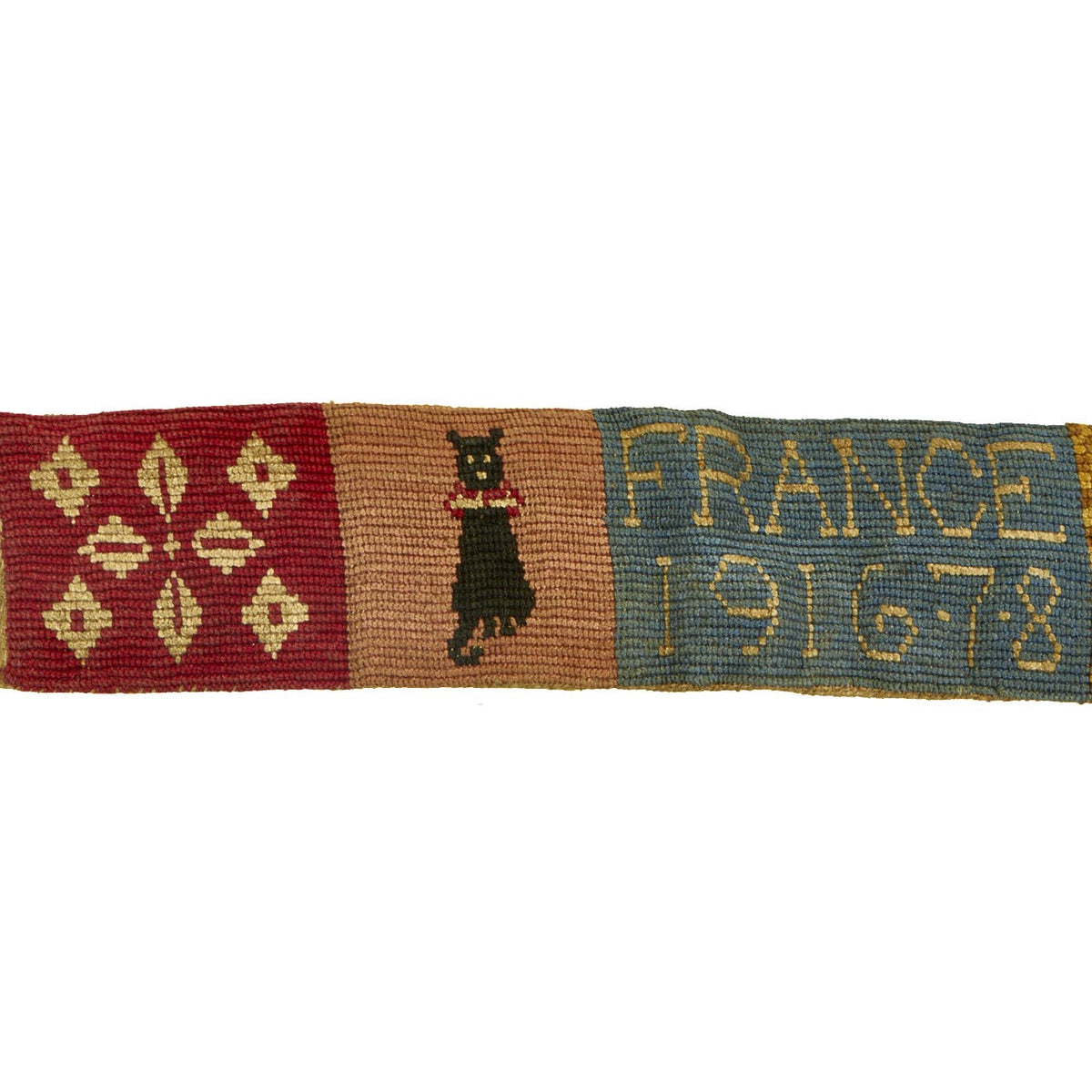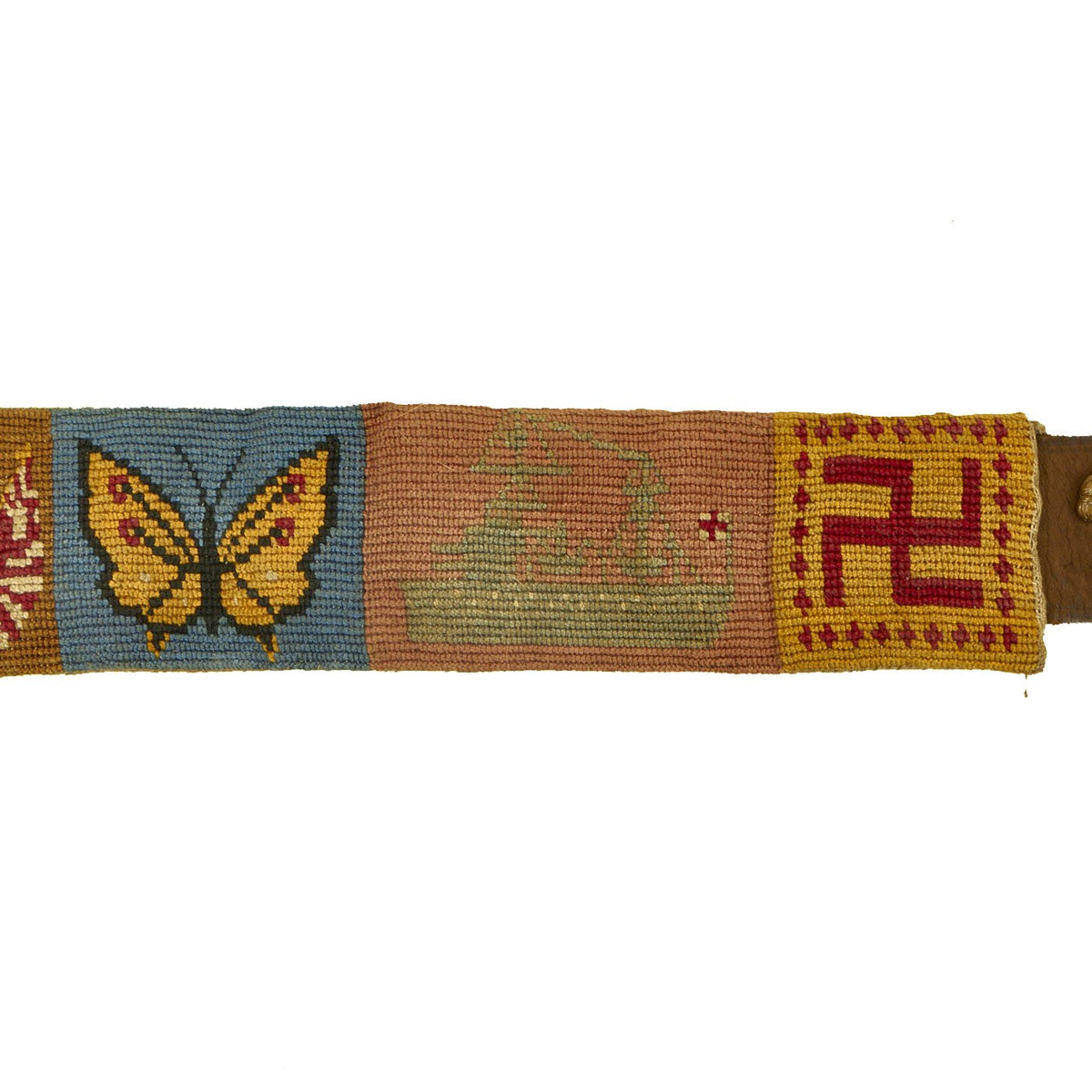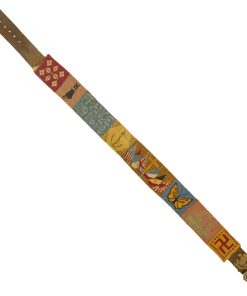Original British WWI Leather Belt in Embroidered Trench Art Sleeve with Welsh Regiment Badge Original Items
$ 295,00 $ 118,00
Original Item: One-of-a-kind. This is a lovely example of WWI British Trench art, in the form of an embroidered sleeve for a leather belt. It has 8 panels in total, including one that reads FRANCE 1916-7-8, indicating where the soldier was serving, and presumably where the belt was made. The other panels include decorations, what looks to be a dog or cat, a Naval Anchor, a butterfly, a battleship, and a yellow panel with a red swas surrounded by tiny red crosses. It should be noted that this is a “left-facing” type used throughout Asia, not the “right facing” type later used by the NSDAP. In the center of the belt is a larger panel with the flags of the 6 Allied / Entente nations (though they are not entirely correct): Great Britain, France, Russia, Italy, Romania, Japan and the United States.
The belt measures about 37 inches long and is 1 3/4 inches wide, with a plated steel buckle on the end. The attached embroidered sleeve measures about 26 1/2 x 2 1/2 inches, and is tack stitched to the belt at the ends.
Next to the buckle is a regimental brass cap badge for the British Welsh Regiment, which shows the three ostrich feathers of the Prince of Wales going through a crown, with a banner reading ICH DIEN (“I Serve”), the motto of the Prince of Wales. Under this is another banner reading THE WELSH, which shows that it was made before 1920, when the name was changed to the archaic “Welch”.
An extremely impressive item that took a lot of time in the trenches to produce! Ready to research and display!
Trench art is any decorative item made by soldiers, prisoners of war, or civilians where the manufacture is directly linked to armed conflict or its consequences. It offers an insight not only to their feelings and emotions about the war, but also their surroundings and the materials they had available to them.
Not limited to the World Wars, the history of trench art spans conflicts from the Napoleonic Wars to the present day. Although the practice flourished during World War I, the term ‘trench art’ is also used to describe souvenirs manufactured by service personnel during World War II. Some items manufactured by soldiers, prisoners of war or civilians during earlier conflicts have been retrospectively described as trench art. There is much evidence to prove that some trench art was made in the trenches, by soldiers, during war.
In With a Machine Gun to Cambrai, George Coppard tells of pressing his uniform buttons into the clay floor of his trench, then pouring molten lead from shrapnel into the impressions to cast replicas of the regimental crest. Chalk carvings were also popular, with contemporary postcards showing carvings in the rocky outcrops of dug-outs. Many smaller items such as rings and knives were made by soldiers either in front line or support trenches, especially in quieter parts of the line.
Wounded soldiers were encouraged to work at crafts as part of their recuperation, with embroidery and simple forms of woodwork being common. Again from With a Machine Gun to Cambrai, George Coppard recalls that, while recuperating from wounds at a private house in Birkenhead, “one kind old lady brought a supply of coloured silks and canvas and instructed us in the art of embroidery. A sampler which I produced under her guidance so pleased her that she had it framed for me.”
An example of therapeutic embroidery during World War I is the work of British military in Egypt, who were photographed sewing and embroidering for Syrian refugees. There was also the Bradford Khaki Handicrafts Club, which was funded in Bradford, UK, in 1918, to provide occupational therapy and employment for men returning from the trenches in France.
Fast Shipping with Professional Packaging
Thanks to our longstanding association with UPS FedEx DHL, and other major international carriers, we are able to provide a range of shipping options. Our warehouse staff is expertly trained and will wrap your products according to our exact and precise specifications. Prior to shipping, your goods will be thoroughly examined and securely secured. We ship to thousands clients each day across multiple countries. This shows how we're dedicated to be the largest retailer on the internet. Warehouses and distribution centres can be located throughout Europe as well as the USA.
Note: Orders with more than one item will be assigned a processing date depending on the item.
Before shipping before shipping, we'll conduct a thorough inspection of the items you have ordered. Today, the majority of orders will be delivered within 48 hours. The delivery time will be between 3-7 days.
Returns
The stock is dynamic and we cannot completely manage it because multiple stakeholders are involved, including our factory and warehouse. So the actual stock may alter at any time. It's possible that you may not receive your order once the order has been made.
Our policy is valid for a period of 30 days. If you don't receive the product within 30 days, we are not able to issue a refund or an exchange.
You can only return an item if it is unused and in the same state as the day you received it. You must have the item in its original packaging.
Related products
Uncategorized
Angolan Rebel 1970s era 60mm Inert Display Mortar from Angolan Civil War Original Items
Uncategorized
Uncategorized
Uncategorized
Uncategorized
Uncategorized
Uncategorized
Uncategorized
Uncategorized
Australian WWII Owen MK1 Machine Carbine SMG Custom Fabricated Replica with Sling Original Items
Uncategorized
Uncategorized
Uncategorized
Uncategorized
Uncategorized
Armoured Fighting Vehicles of the World: AFVs of World War One (Hardcover Book) New Made Items
Uncategorized
Uncategorized
Uncategorized
